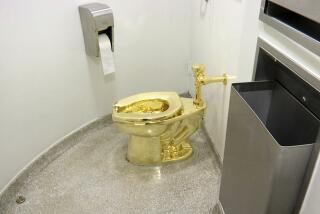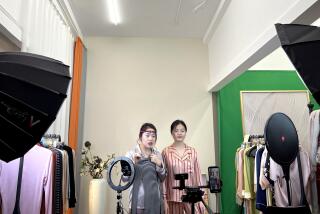In China, nothing says ‘upwardly mobile’ like a $6,000 toilet
- Share via
Reporting from Beijing — Like Goldilocks searching for the perfect perch, Dong Yu tested one seat after another in the glitzy showroom. Some were too pricey, others too fussy. Then he found one that was just right.
“You’ve got to try this,” he shouted to his wife, to the delight of a fawning saleswoman. “This one’s really comfortable.”
The seat in question was a $400 toilet made by Japan-based Toto Ltd. Dong and his wife had just bought a 2,200-square-foot apartment in a tony section of China’s capital and were prepared to splurge on a pair of eye-catching commodes. This model, with its slim tank and ultra-quiet flush, was exactly what the couple were looking for.
“Today, Chinese people like to focus on the kitchen and the bathroom in their new apartments,” said Dong, 37. “It’s a big difference from when I was a kid. We had to share public bathrooms, which only had squat toilets.”
China’s housing boom has unleashed a bull market in fancy plumbing. No longer content with low-tech latrines, upwardly mobile Chinese are snapping up cutting-edge toilets loaded with high-efficiency flushing systems, heated seats and built-in bidets.
The surge underscores the desire of millions of Chinese to enjoy a better standard of living. And it has been a bonanza for plumbing manufacturers, which are vying for a piece of the world’s largest loo market. Nearly 19 million toilets are sold in China annually, about double the number sold in the U.S., said Victor Post, vice president of BRG Consult, a global building products consultancy.
“China is the most competitive market in the world,” said Larry Yuen, president of Kohler Asia, which has 11 factories in China. “There are brands from Japan, Europe and America all fighting for market share.”
China’s porcelain revolution took off soon after the communist government gave the green light to private property development just more than a decade ago. Since then, the amount of new urban residential space unveiled each year has doubled. Most apartments are delivered bare, meaning buyers have to outfit them with basics such as bathroom fixtures.
Although many are satisfied with Western-style toilets that often cost no more than $20 here, pricier name brands are gaining traction. Models costing anywhere from $150 to $6,000 now account for about 5% of the toilets sold in China each year, according to Toto officials. The Japanese company has been riding robust growth here, peddling commodes with sleek designs and features such as oscillating bidets, air fresheners and blow dryers.
“As far as toilets go, we think this is top of the line,” said Banse Katsuya, project sales manager for Toto China, standing proudly over a $5,900 Neorest series bowl in the company’s flagship store in Beijing.
Outfitted with buttons labeled “rear cleansing” and “front cleansing” (and it’s not referring to the bowl), the Space Age device features a heated seat and a water-saving, but powerful, hands-free sensor flush.
The technology is nothing new in Japan, where units with built-in bidets, known as washlets, are commonplace even in public restrooms. But in China, the nouveaux riches have only recently begun to accept bells and whistles with their thrones.
“Our goal is to make these kinds of functionalities basic for everyone,” said Takahiro Yanagihara, director of Toto China, which operates nine factories in the country and whose sales have risen 10% every year for the last decade. “We believe demand will continue to grow as urbanization continues to grow. People have more money to spend, and they want to be comfortable.”
Toto has increased its Chinese marketing budget in recent years, Yanagihara said. It appears to be working. He said the company’s washlet sales in China have tripled since 2004.
In one television spot broadcast here, an actress touts the product by saying, “It’s just like a spa.” Then, using computer-generated animation that’s short on subtlety, the commercial demonstrates how the bidet function works.
There’s good reason for such instruction. Squat toilet habits are hard to break in China, particularly among the older generation. Women’s public restrooms commonly include signs asking visitors not to stand on the seats. The telltale sign it’s too late? A set of footprints.
American Standard, whose operations in Asia are owned by a Japanese conglomerate, is also trying to educate Chinese consumers. In a multistory bathroom supply store in Beijing, company saleswoman Zhang Min showed off a $3,800 Eurozen model, which had pride of place on a glass pedestal. Her frank pitch focused on human plumbing.
“We’re targeting the younger generation. They’re more aware of hygiene,” Zhang said. “Though I keep telling older people that the bidet helps with constipation.”
Across town, rival Kohler Co. of Wisconsin displays its elegantly designed bowls in a recently renovated showroom. One had a decorative gold band across its tank, another didn’t have a tank at all. Opening the lid required just a nudge with a fingertip; a mechanism did the rest. Price tag: $5,000.
Though Kohler, a privately-owned company, won’t divulge sales figures, Yuen, the Asia president, said the manufacturer is benefiting from younger Chinese unafraid to show off their wealth. He said consumers here have a special affinity for the bathroom.
“It’s the only place in your home you can have privacy,” he said. “A lot of people still live with their grandparents and parents.”
To better suit the Chinese market, some Kohler toilets are made a few inches shorter than in the U.S. And in a nation where nearly 1 in 4 residents smoke, Kohler salespeople in China often brag that their flushing system is powerful enough to suck down all the remnants of an emptied ashtray.
“We’ve done this demonstration over and over,” said Eric Sun, a company official.
But in China, substandard plumbing and overloaded city sewers can make all that performance feel wasted. Blockages are common, plumbing work can be shoddy, and pipes often are placed too close to floorboards. A well-known joke in China goes like this: If you need a bathroom, just follow your nose.
“Our biggest challenge is installation,” Yuen said. “It’s why we’re promoting and working with certified Kohler plumbers. There’s just a lot of ignorance and second-rate piping out there.”
Zhang Li, 36, grew up in one of Beijing’s old courtyard neighborhoods where the odor of the public bathrooms was never far away. Such intimacy may have strengthened community bonds. But the real estate agent has no regrets about stocking her luxury apartment with Kohler fixtures.
“I think we’ve earned the right to have clean, nice bathrooms,” she said.
david.pierson@latimes.com
Nicole Liu and Tommy Yang in The Times’ Beijing bureau and Kenji Hall in Tokyo contributed to this report.
More to Read
Inside the business of entertainment
The Wide Shot brings you news, analysis and insights on everything from streaming wars to production — and what it all means for the future.
You may occasionally receive promotional content from the Los Angeles Times.











